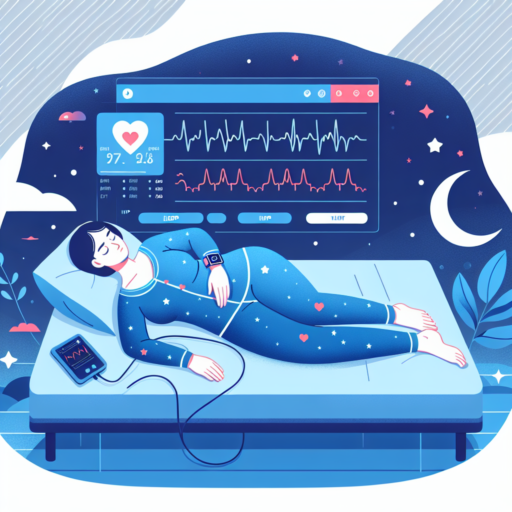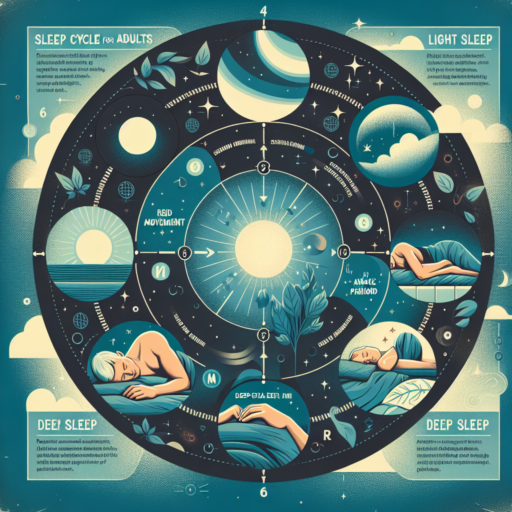Introduction to Sleep Tracking: Understanding the Basics
Sleep tracking has emerged as a revolutionary approach to understanding and improving the quality of our sleep. With the rise of smart technology and wearable devices, monitoring sleep patterns has become more accessible than ever. This introductory guide aims to provide you with the fundamental knowledge required to embark on your journey of sleep tracking.
Why Monitor Your Sleep?
At its core, the purpose of sleep tracking is to gain insights into your sleep behaviors and cycles. By understanding when you go through different stages of sleep, such as REM (Rapid Eye Movement) and deep sleep, you can make informed decisions to enhance the quality of your rest. This data not only helps identify potential sleep disruptions but also plays a crucial role in improving overall health and wellbeing.
How Does Sleep Tracking Work?
Modern sleep trackers utilize a variety of sensors to monitor movements, heart rate, and even oxygen levels in your blood while you sleep. These devices then use algorithms to analyze the data and provide a detailed breakdown of your sleep stages. Whether you choose a wearable device or a non-wearable option, such as a bed-based sensor, the ultimate goal is to collect accurate information about your sleep patterns. Emphasizing the importance of choosing the right sleep tracker is essential, as it should suit your lifestyle and provide data that you can act upon to improve your sleep quality.
Choosing the Right Sleep Tracking Method for You
When it comes to improving your sleep quality, understanding your sleep patterns is the first step. There are several methods you can use to track your sleep, each with its own set of benefits and drawbacks. In this guide, we’ll explore various sleep tracking methods to help you find the right one for your needs.
Wearable Devices
Many people opt for wearable devices such as fitness trackers and smartwatches to monitor their sleep. These devices provide data on various aspects of your sleep, including sleep duration, sleep quality, and sleep stages (light, deep, and REM sleep). While they offer the convenience of tracking automatically, it’s important to choose a device that is comfortable to wear overnight and is accurate in sleep assessment.
Mobile Apps
Another popular method is the use of mobile apps designed for sleep tracking. These apps often use the accelerometer in your phone to measure movement and infer sleep quality. Some apps also incorporate sound recording to detect snoring or sleep apnea risks. However, the accuracy of mobile apps can vary, and keeping a phone in your bedroom might disrupt your sleep due to electromagnetic radiation or blue light emissions.
Manual Tracking
For those who prefer a more traditional approach, manual tracking using a sleep diary is still a valuable option. This method requires no special equipment beyond a pen and paper. You simply record the times you go to sleep and wake up, how many times you wake up during the night, and how rested you feel in the morning. Though it may lack the detail of technological methods, manual tracking can be a great way to initiate mindfulness about your sleep habits and patterns.
Top Apps and Devices for Sleep Tracking in 2023
With the increasing awareness about the importance of sleep for overall health, the market for sleep tracking technology has significantly expanded. In 2023, numerous apps and devices are competing to offer the most accurate and beneficial features to help users monitor and improve their sleep patterns. Identifying the top options can help individuals make informed decisions about which technology suits their personal sleep goals and lifestyle the best.
The Leading Sleep Tracking Apps of 2023
In the realm of smartphone applications, sleep tracking apps have evolved to not only monitor sleep but also provide actionable insights to enhance sleep quality. Among the frontrunners, Sleep Cycle and Headspace Sleep stand out for their user-friendly interfaces and comprehensive analysis. Sleep Cycle uses sound analysis technology to monitor sleep stages, while Headspace Sleep offers guided meditation to aid in falling asleep faster.
Must-Have Sleep Tracking Devices
For those who prefer a more detailed analysis, wearable devices and non-wearable bedroom gadgets have taken sleep monitoring to a new level. The Fitbit Sense and the Oura Ring are notable for their ability to track not just sleep, but also other health metrics like heart rate and temperature, which can affect sleep quality. Non-wearable devices, such as the Withings Sleep Tracking Mat, offer the advantage of not having to wear anything to bed, while providing detailed reports on sleep cycles, heart rate, and snoring patterns.
No se han encontrado productos.
How to Use Wearable Devices to Monitor Your Sleep
Monitoring sleep has become an essential part of understanding and improving overall health. Wearable devices offer a convenient and efficient way to gather data about your sleep patterns. To effectively use these devices, it’s crucial to wear them correctly and understand the data they provide.
Selecting the Right Wearable Device
Choose a wearable device that is comfortable to wear during sleep and offers detailed sleep tracking features. Look for features like REM cycle detection, heart rate monitoring, and movement tracking. It’s important to read reviews and compare different devices to find one that suits your specific needs and comfort preferences.
Understanding the Data Collected
Most wearable devices provide insights into various aspects of your sleep, such as sleep duration, number of awakenings, time spent in each sleep stage, and overall sleep quality. Pay attention to trends in your sleep data over time, as this can reveal changes in your sleep patterns that might not be immediately apparent. Use this information to adjust your sleep habits and environment for better sleep quality. For example, you may notice you sleep better on days when you exercise or when you go to bed at a consistent time.
Integrating Wearable Technology into Your Sleep Routine
Consistency is key when monitoring sleep with a wearable device. Wear it every night to collect comprehensive data about your sleep patterns. Some devices also offer features like smart alarms, which can help you wake up during a lighter sleep stage, making it easier to get out of bed. Additionally, many wearable devices come with apps that provide detailed reports and insights, along over specific tips for improving your sleep based on your data.
Improving Sleep Quality: How Sleep Tracking Can Help
Many individuals struggle with getting a good night’s rest, unaware that the solution might lie in the technology available at their fingertips. Sleep tracking has emerged as a groundbreaking tool for enhancing sleep quality, offering insights that can lead to better sleep habits. By understanding the intricacies of our sleep cycles through these advanced technologies, we can make informed decisions that boost our overall health and wellness.
This technique involves monitoring various parameters while you sleep, including the duration, consistency, and stages of sleep. With the use of wearables or smartphone apps, individuals can gain a clearer picture of their sleep patterns. The data collected can reveal underlying issues that might be interrupting sleep, such as periods of restlessness or waking moments during the night. Consequently, this information paves the way for targeted improvements.
Moreover, personalized recommendations generated from sleep tracking data can significantly impact one’s sleep routine. For instance, it might suggest optimal sleep and wake times, or recommend lifestyle changes like adjusting caffeine consumption or evening screen time. By tailoring these suggestions to individual needs and habits, sleep tracking offers a bespoke approach to enhancing sleep quality.
Interpreting Your Sleep Data: What the Numbers Mean
Understanding your sleep data is crucial in recognizing the quality of your rest. When you wake up and review the numbers your sleep tracking app or device has collected overnight, you might wonder what those hours, percentages, and graphs really indicate about your slumber. Breaking down these figures can help you make informed decisions about your sleep habits and overall health.
Duration of Sleep: More Than Just Hours
One of the most straightforward metrics to interpret is the total duration of sleep. While the general recommendation is to aim for 7 to 9 hours per night for adults, it’s essential to delve deeper into the types of sleep you are getting. The proportion of REM (Rapid Eye Movement) sleep, deep sleep, and light sleep within those hours is pivotal. An imbalance in these stages can affect how rested you feel, even if you’re hitting the 8-hour mark.
Sleep Efficiency and Interruptions
Your sleep tracker may also provide insights into your sleep efficiency, which is a percentage calculated by dividing the total time spent asleep by the total time spent in bed. A high sleep efficiency percentage indicates a quality rest with minimal awakenings. Conversely, frequent interruptions or prolonged periods of wakefulness during the night can decrease this number, highlighting possible sleep disorders or environmental disturbances impacting your rest.
Integrating Sleep Tracking into Your Daily Routine
In the bustling rhythm of modern life, the importance of a good night’s rest cannot be overstated. Yet, many of us struggle to understand the quality and quantity of sleep we’re getting. Integrating sleep tracking into your daily routine can be a revolutionary step towards enhancing your overall health and wellbeing. By keeping a close watch on your sleep patterns, you’re not just monitoring rest but unlocking the potential to improve your waking hours as well.
Starting with a simple habit of noting down when you go to bed and when you wake up can pave the way for a more detailed sleep tracking regimen. Advances in technology now allow for a range of devices and apps designed to monitor sleep. These tools can provide insights into not just how long you’re sleeping, but the quality of sleep as well, including stages such as REM and deep sleep. Understanding these patterns can help you pinpoint what factors are aiding or hindering your sleep.
Moreover, integrating sleep tracking doesn’t have to be an invasive part of your routine. Many devices offer non-intrusive methods of monitoring, such as wearable wristbands or even mattresses equipped with smart technology. The data collected from such devices can then be analyzed to offer personalized suggestions and adjustments to your sleep habits. This might include recommended bedtimes or even slight lifestyle adjustments that could significantly improve your sleep quality.
Tips for Maximizing the Benefits of Sleep Tracking
Sleep tracking technology has advanced significantly, offering individuals the opportunity to gain a deeper understanding of their sleep patterns and overall health. However, to truly maximize the benefits of sleep tracking, it’s essential to leverage the data effectively and incorporate it into a holistic health plan. Below are practical tips for making the most out of your sleep tracking efforts.
Understand the Data You’re Collecting
Begin by familiarizing yourself with the metrics your sleep tracker provides. Common data points include sleep duration, sleep stages (REM, light, and deep sleep), and interruptions. Knowing what each metric means and how it relates to your health and well-being is crucial. For instance, if you notice frequent sleep interruptions, this might be a signal to improve your sleep environment or examine potential underlying health issues.
Set Realistic and Personalized Goals
Once you understand the data, set realistic sleep goals based on your unique needs and lifestyle. For example, if you typically get six hours of sleep but feel tired throughout the day, aim for a gradual increase to seven or eight hours per night. Ensure your goals are specific, measurable, and attainable to monitor progress effectively. This personalized approach helps in creating a targeted plan that addresses your specific situations and challenges.
Adjust Your Routine Based on Insights
Use the insights from your sleep tracker to fine-tune your bedtime routine for optimal sleep quality. If you’ve noticed that your deep sleep is lacking, consider adjusting factors such as room temperature, light exposure, or bedtime activities that could be interfering with your sleep cycles. Additionally, integrating relaxation techniques, such as meditation or reading, before bed can further enhance the quality of your sleep. Regularly revisiting and adjusting your routine as you gather more data ensures a continuously improving sleep experience.
Common Mistakes in Sleep Tracking and How to Avoid Them
Keeping track of your sleep can be a powerful tool to improve your well-being, but it’s easy to fall into common pitfalls that may end up misleading rather than guiding. Understanding these mistakes and how to sidestep them ensures that your efforts to monitor your sleep patterns become more effective and informative.
Obsessing Over Data Without Observing Patterns
One of the most frequent mistakes in sleep tracking is getting too caught up in nightly data without analyzing long-term patterns. While nightly metrics can be useful, it’s the overarching trends that provide actionable insights. To avoid this, focus on weekly or monthly summaries rather than fixating on minor daily fluctuations. This approach allows for a broader understanding of your sleep health and identifies habits that either benefit or hinder your rest.
Neglecting Sleep Hygiene for the Sake of Numbers
Another pitfall is letting the pursuit of ‘perfect’ numbers overshadow the importance of good sleep hygiene. Focusing solely on achieving specific sleep scores can lead some to ignore the fundamental practices that foster healthy sleep, such as maintaining a regular bedtime, limiting screen time before bed, and ensuring a comfortable sleep environment. Remember, quality trumps quantity when it comes to meaningful sleep tracking.
Not Syncing Data with Lifestyle Choices
Failing to consider how daily activities impact sleep data is a major oversight. Everything from caffeine consumption to exercise routines can significantly influence sleep patterns. To truly understand and improve your sleep quality, it’s crucial to not only track your sleep but also note daytime habits. Implementing a system to record these activities alongside your sleep data can unveil correlations that are pivotal for making positive changes.
The Future of Sleep Tracking: Trends and Innovations
The realm of sleep tracking is on the brink of a revolutionary change, driven by cutting-edge technology and a deeper understanding of sleep science. As we head further into the future, the convergence of AI, wearable tech, and advanced analytics promises to transform how we monitor and manage our sleep. This evolution is not just about the quantity of sleep but also places a strong emphasis on the quality and the intricate patterns of our sleep cycles.
One of the most exciting trends in this domain is the shift towards non-invasive methods of tracking. Innovations in the form of smart beds and ambient sensors are set to redefine the sleep tracking landscape. These technologies aim at collecting data seamlessly without the need for direct contact with the user, making sleep tracking more comfortable and less intrusive. The integration of these devices with smart home systems could offer unprecedented insights into our sleep health, potentially leading to more personalized and effective sleep improvement strategies.
In addition to hardware innovations, we’re also witnessing a surge in sophisticated software solutions that leverage machine learning and big data analytics. These tools are becoming increasingly adept at interpreting sleep data, identifying patterns and anomalies that were previously unnoticed. Such advances in software are crucial for providing actionable feedback to users, empowering them to make informed decisions about their sleep habits and overall health.




